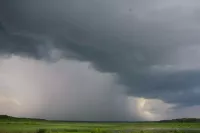The Storm Prediction Center (SPC) is a United States government agency nested within the National Centers for Environmental Prediction (NCEP), the National Weather Service (NWS), and the National Oceanic and Atmospheric Administration (NOAA), ultimately under the Department of Commerce (DoC). The SPC's core function is to forecast severe weather events, particularly tornadoes, severe thunderstorms, and related hazards, across the contiguous United States. It provides forecasts and warnings to inform the public, emergency management agencies, and other stakeholders about potential severe weather risks, playing a critical role in mitigating damage and saving lives.
1952: Severe Local Storms Unit (SELS) Established
In 1952, the Storm Prediction Center began as the Severe Local Storms Unit (SELS) within the U.S. Weather Bureau in Washington, D.C.
1954: SELS Moved to Kansas City
In 1954, the Severe Local Storms Unit moved its forecast operations to Kansas City, Missouri.
1955: SELS Issued Convective Outlooks
In 1955, the Severe Local Storms Unit began issuing convective outlooks for predicted thunderstorm activity.
1960: SELS Issued Radar Summaries
In 1960, the Severe Local Storms Unit began issuing radar summaries in three-hour intervals.
1966: SELS Became NSSFC
In 1966, the Severe Local Storms Unit became the National Severe Storms Forecast Center (NSSFC) due to increased duties, remaining headquartered in Kansas City.
1968: NSSFC Issued Status Reports on Weather Watches
In 1968, the National Severe Storms Forecast Center began issuing status reports on weather watches.
1971: First Computerized Data Transmission
In 1971, the National Severe Storms Forecast Center made its first computerized data transmission.
April 2, 1982: First "Particularly Dangerous Situation" Watch Issued
On April 2, 1982, the National Severe Storms Forecast Center issued the first "Particularly Dangerous Situation" watch, indicating an imminent threat of a major severe weather event.
1986: New Forecast Products Introduced
In 1986, the National Severe Storms Forecast Center introduced two new forecast products: the Day 2 Convective Outlook and the Mesoscale Discussion.
October 1995: NSSFC Relocated and Renamed SPC
In October 1995, the National Severe Storms Forecast Center relocated to Norman, Oklahoma, and was renamed the Storm Prediction Center.
1998: National Fire Weather Outlook Issued
In 1998, the Storm Prediction Center began issuing the National Fire Weather Outlook to provide forecasts for areas susceptible to wildfires.
2000: Experimental Day 3 Convective Outlook
In 2000, the Day 3 Convective Outlook was first issued on an experimental basis.
2001: Official Day 3 Convective Outlook
In 2001, the Day 3 Convective Outlook was made an official product.
April 7, 2006: Day 2 High Risk Issued
On April 7, 2006, a Day 2 high risk was issued by the Storm Prediction Center.
2006: SPC Moved to National Weather Center
In 2006, the Storm Prediction Center moved its operations into the newly constructed National Weather Center in Norman, Oklahoma.
March 22, 2007: Day 4-8 Outlook Became Official Product
On March 22, 2007, the Storm Prediction Center incorporated the Day 4–8 outlook as an official product.
April 1, 2009: Product Issuance Responsibilities Reassigned
On April 1, 2009, the Storm Prediction Center reassigned responsibilities for issuing the center's products in outage situations to the 15th Operational Weather Squadron based out of Scott Air Force Base.
April 2011: Graphical updates for categorical levels of risk
In April 2011, the SPC introduced a new graphical format for its categorical and probability outlooks, which included the shading of risk areas and population, county/parish/borough and interstate overlays.
April 2011: New graphical format introduced
In April 2011, the Storm Prediction Center introduced a new graphical format for its categorical and probability outlooks, including the shading of risk areas and revised color palettes.
April 14, 2012: Day 2 High Risk Issued
On April 14, 2012, a Day 2 high risk was issued by the Storm Prediction Center.
June 2012: SPC Forecasts General Thunderstorm Risk Areas
As of June 2012, the SPC forecasts general thunderstorm risk areas.
2013: Table incorporated under Convective Outlook's risk category
In 2013, the SPC incorporated a small table under the Convective Outlook's risk category map that indicates the total coverage area by square miles, the total estimated population affected and major cities included within a severe weather risk area.
April 21, 2014: Public comment period for additions to the Convective Outlooks
On April 21, 2014, the Storm Prediction Center began asking for public comment on proposed categorical additions to the Day 1-3 Convective Outlooks for a two-month period.
October 2014: Marginal and enhanced risk categories added
Even after the marginal and enhanced risk categories were added in October 2014, some television stations have continued to use the original three-category system to outline forecasted severe weather risks.
October 22, 2014: Enhanced Risk Category Added
On October 22, 2014, the upper end of the SLGT category was replaced with the "ENH" category for enhanced risk.
January 28, 2020: Probabilities for tornadoes, hail and wind incorporated into the Day 2 Convective Outlook.
On January 28, 2020, probabilities for tornadoes, hail and wind applying to the Day 1 Convective Outlook were incorporated into the Day 2 Convective Outlook. The individual hazard probabilistic forecasts replaced the existing "total severe" probability graph for general severe convective storms that had been used for the Day 2 outlook beforehand.
January 28, 2020: Specific probabilities for tornadoes, hail, or wind issued for Day 1 outlook.
Prior to January 28, 2020, the Day 1 was currently the only outlook to issue specific probabilities for tornadoes, hail or wind. The Day 1 Convective Outlook provides a textual forecast, map of categories and probabilities, and chart of probabilities.
August 13, 2024: Day 3 Outlooks Issued Twice Daily
Since August 13, 2024, Day 3 outlooks are issued twice daily at 0730Z in Daylight Saving Time or 0830Z in Standard Time and 1930Z.
March 15, 2025: Day 2 High Risk Issued
On March 15, 2025, a Day 2 high risk was issued by the Storm Prediction Center.
March 2025: DOGE Announced NOAA Office Terminations
During March 2025, the Department of Government Efficiency (DOGE) had announced other NOAA office terminations.
March 2025: Number of Meso-Gamma Mesoscale Discussions Issued
As of March 2025, the Storm Prediction Center has issued 44 meso-gamma mesoscale discussions.
March 17, 2025: Report of SPC Closure
On March 17, 2025, ABC News reported, from an anonymous source, that the Storm Prediction Center was set to be closed by the Department of Government Efficiency (DOGE).
April 28, 2025: Day 3 Moderate Risk Issued
On April 28, 2025, a Day 3 moderate risk was issued by the Storm Prediction Center. These have been issued only twenty-two times since the product became operational.
Mentioned in this timeline

Radar is a radiodetermination system using radio waves to detect...

Washington D C is the capital city and federal district...

Weather forecasting employs scientific and technological methods to predict atmospheric...

Thunderstorms also known as electrical or lightning storms are characterized...
The National Weather Service NWS is a US federal agency...
Oklahoma is a state in the South Central region of...
Trending
15 days ago Mike Evans, McMillan, and Kancey Aim for Return Before Season's End

1 month ago Upstart's Q3 Earnings: Mixed Results, Soft Q4 Guidance, and Stock Slides After Announcement.

8 days ago Trump's performance at December 2025 Cabinet meeting raises concerns about his health and focus.
7 months ago Severe Thunderstorms Expected in Alabama: High Winds and Heavy Rainfall Possible

2 months ago HBO's 'Welcome to Derry': Stephen King Prequel, Pennywise Haunts, Questions Arise About Ruining Masterpiece
2 months ago Sleep Token Accused of IG Shutdown Over Tattoo Copyright: Artist Claims Label Involved
Popular

Candace Owens is an American conservative political commentator and author...
Matt and Ross Duffer known as the Duffer Brothers are...

Ilhan Omar is an American politician currently serving as the...

XXXTentacion born Jahseh Dwayne Ricardo Onfroy was a controversial yet...

Tom Cotton is an American politician and Army veteran currently...
The Kennedy Center Honors are annual awards recognizing individuals and...